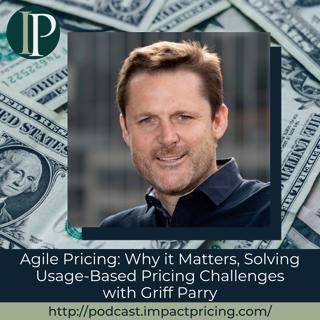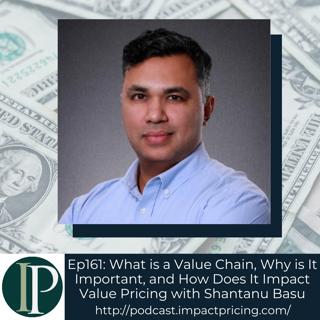
What is a Value Chain, Why is It Important, and How Does It Impact Value Pricing with Shantanu Basu
Shantanu Basu is currently the Senior Director of Go-To Marketing Strategy and Operations at Tanium. He was Director of Strategy and Operations at Intel for a long time, and he's part of an organization called RevGenius. Shantanu got his MBA from the University of Michigan. In this episode, Shantanu discusses value chain alignment alongside the importance of knowing what your value is and understanding what your customers think what your value is. Why you have to check out today’s podcast: Discover why knowing your company’s value and understanding how your customer sees value in you when doing pricing; Understand the importance of doing things one at a time, especially when communicating about the company’s value chain; and Find out why it’s necessary for you to be able to ask the right value chain alignment questions “When you think of yourself as a pricing professional, you're doing your pricing jobs so to speak, don't limit yourself to what somebody else might consider the definition of your job. As a pricing professional, you should be able to ask questions and articulate – if you ask the right questions; articulate the value of your product across the entire value chain.” – Shantanu Basu Topics Covered: 01:47 – How Shantanu got into pricing alongside the discussion around capturing and communicating value 04:20 – Knowing your value vs. understanding what your customers think your value is 10:34 – How he communicates with people to help them understand how the value chain inside that company looks like 13:57 – The difference between being right and being effective in doing pricing 17:58 – How to align product positioning with packaging 22:34 – Discussion around the good, better, best framework 26:35 – Briefly talking platform pricing and how it intersects with good, better, best 30:49 – Shantanu’s piece of pricing advice for today’s listeners Key Takeaways: “Do you understand how value is created for your product, your business, your industry? Do you know how to communicate and then, hence, capture that value? It starts and ends with value. As long as you can connect those different points along the value chain, you perhaps have something to go to market with.” – Shantanu Basu “Change comes from understanding. If I don't understand how my product positioning team and/or my sales team thinks our value is, I don't know how to influence that change, assuming I am right in understanding what the customer said.” – Shantanu Basu “Every time there is a shift to be made from our steady state, you start to ask these questions and go try to reach as far back into the value chain as you can without pissing off too many people and slowing down business. It becomes an art rather than a science.” – Shantanu Basu “Change management is not about right and wrong or numbers or the customer. It's about people and the emotions and maneuvering the informal dynamics of an organization, which I would like to think it only comes with experience.” – Shantanu Basu “Pricing isn't rocket science. Influencing change via pricing and influencing the right behavior – whether of your customer, your sales rep, your CEO, or your customer success person – is where the art comes in.” – Shantanu Basu “You don't have to be an expert in every piece of the value chain. That's not your job. There are people who will always do better than you. But stretch all the way down the value chain and all the way up the value chain and feel free and empowered to ask questions at each point so that you understand the entire value chain. Because when it comes down to this “simple piece of pricing”, your understanding across the value chain is what's going to probably provide the best results, not just coming up with a number and not just coming up with X.” – Shantanu Basu People / Resources Mentioned: Tanium: https://www.tanium.com/ Stephanie Hallford: https://www.linkedin.com/in/stephanie-hallford-ba90732 Connect with Shantanu Basu: LinkedIn: https://www.linkedin.com/in/basushantanu/ Email: basu@gmail.com Connect with Mark Stiving: LinkedIn: https://www.linkedin.com/in/stiving/ Email: mark@impactpricing.com
21 Feb 202233min
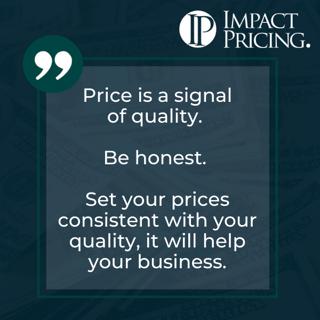
Memecast #46: Signal of Quality
We all know that price is a signal of quality, but what ends up happening is, over time people learn what the true quality is, and they realize if the prices match that true quality or not. If we're able to price relative to our true quality, then all is right with our customers in their minds and they're not going to change their purchase decisions. They're more likely to stick with us. Now, what happens if we deliver a ton of quality and we charge a low price? Well, first off, maybe a lot of people aren't going to find out because they're using our price as an indicator of quality. And they say, oh, that's way too inexpensive. It's not a product that would fit my needs. So, they never learned that yours is great. Once of course, someone buys in and they start using it, then sure, they say, hey, this is a fantastic deal. Maybe they talk about it, word of mouth. The question becomes, can you get people to buy it because it's such a low price. On the other hand, let's say you charge a really high price for something. And then they take it home, they realize, oh, this really isn't worth that price. Now we get negative word of mouth. People tend not to buy. They're certainly not going to buy again. “Price is a signal of quality.” - Mark Stiving It's so much easier if we could figure out what our quality levels really are and set our prices consistent with what those quality levels are. It's a great way to build a long-term sustainable business. We hope you enjoyed this memecast. If you have any questions or feedback, please email me mark@impactpricing.com. Now go make an impact. Connect with Mark Stiving: Email: mark@impactpricing.com LinkedIn: https://www.linkedin.com/in/stiving/
18 Feb 20222min
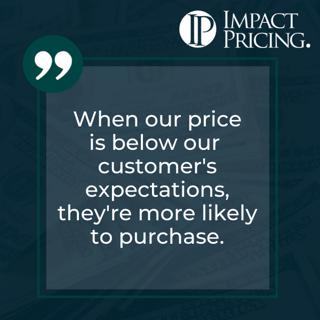
Memecast #45: Reference Prices
There's a concept in economics, behavioral economics, called reference prices. And reference prices really say our customers have some expectation about what they think they're going to pay. And if our price is below that expectation, they get a good feeling they're getting a good deal. And the fact that they're getting a good deal provides them an incentive or the good feelings that say I'm actually going to buy. Richard Thaler broke this up into two different types of utility. There's transaction utility and there's functional utility. The functional utility is the utility that someone gets from our product. It's the reason they're buying it. But transactional utility is the feelings you get when you're going to buy something. And if you walk into a store expecting to pay $20, and you find it on sale for 15, you're thinking, Hey, that's a really neat deal, I'm going to buy that. Or you're more likely to buy it. "We should be paying attention to our customer's expectations." - Mark Stiving If we have a way to control expectations, to raise expectations before they actually buy, and then we give them a price that's below those expectations, it makes it more likely they'll pull out their wallet and buy from us. We hope you enjoyed this podcast. If you see have any questions or feedback please email me mark@impactpricing.com. Now go make an impact. Connect with Mark Stiving: Email: mark@impactpricing.com LinkedIn
16 Feb 20221min
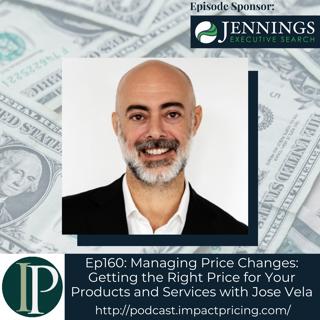
Managing Price Changes: Getting the Right Price for Your Products and Services with José Vela
José Vela is the Director of Pricing at Spandex Barcelona, known as one of the leading suppliers of graphics and digital materials worldwide. He is a strategic and business savvy leader who empowers business development and profitability improvements for global businesses, with an expertise in directing international trade, manufacturing, and services operations. José moved into pricing after having a General Manager's role. In this episode, José talks about the importance of getting the right price in selling your services as he relates it to the change and value you’re providing to your customers. Why you have to check out today’s podcast: Understand why it’s a must for you to be able to price your products and services right in relation to winning more deals even at a high price; Discover how experience adds up to a pricing person’s credibility, therefore, resulting to high rates of success in sales; and Find out how necessary it is for you to think like your customers in order to provide the best value in the market. “You need to be able to analyze your own data in order to identify where your margin, your profitability is, what are the leakages, and then you need to act on them.” – José Vela Topics Covered: 01:49 – Getting into the world of pricing: Winning more deals through knowing the right price 05:52 – General managers providing more credibility to the table and being able to demonstrate success through experience 09:00 – The value being present on the extended product; thinking like the customers 13:15 – Building the analytics capability to prove the impact of pricing decisions 16:49 – Why list prices matter so much 18:00 – How to effectively manage list prices in relation to the benchmarks 23:07 – José’s piece of pricing advice for today’s listeners Key Takeaways: “Most of the time, sales people – they are driven when we are talking about pricing. They are driven by fear. They are afraid of losing the deal, losing the customer if they base off them. And if you are able to provide them data, reliable information, they feel more confident and they know that they can offer a right price and they know it right because other similar customers are paying.” – José Vela “Country managers are really competitive. We are competitive animals and we know to overperform. We want to overachieve. And if we see that some of our colleagues are succeeding, we want to know what's the deal, what's going on there, because we want to replicate this, these tools, those processes, whatever they are doing to succeed. We want to make sure that we are doing the best in order to succeed too. So, if you are able to find early adopters that are able to show and demonstrate quick wins, this also helps a lot.” – José Vela “The impact of pricing is, how do we manage the list prices? And how do we manage the discounts that we are giving to our customer? The main driver for margin value is – without any doubt – how do you manage your pricing? And if you are not able to organically growth a lot for whatever the reason, how you manage your list prices is the biggest driver to increase your revenue.” – José Vela “In general, it's not just pricing the prices. It’s making the right price. Pricing goes in two directions. It’s not only about rising prices. Sometimes, you decrease.” – José Vela “Most of the pricing initiatives, the critical piece is never the technology, or at least from my point of view, because there are different ways to do stuff, different platforms, but how do you manage the change? How do you train the people? How do you make them feel comfortable and embrace the change? That's the most difficult part. Ever. Always.” – José Vela People / Resources Mentioned: Spandex: https://www.spandex.com/ Toyota: http://www.toyota.com/ Connect with José Vela: LinkedIn: https://www.linkedin.com/in/jvela/ Email: jjvelar@gmail.com Connect with Mark Stiving: LinkedIn: https://www.linkedin.com/in/stiving/ Email: mark@impactpricing.com
14 Feb 202226min

Blogcast #41: Opportunity Costs and Pricing
This is an Impact Pricing Blog published on January 5, 2021, turned into an audio podcast so you can listen on the go. Read Full Article Here: https://impactpricing.com/blog/opportunity-costs-and-pricing/ If you have any feedback, definitely send it. You can reach us at mark@impactpricing.com. Now, go make an impact. Connect with Mark Stiving: Email: mark@impactpricing.com LinkedIn
11 Feb 20223min
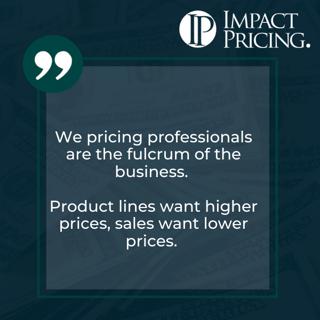
Memecast #44: Fulcrum
As pricing professionals, we really need to be the logical part of the business. Our product lines, they really want higher prices. Sometimes they become emotionally involved with their products and they think that they're worth a ton - and they probably are. Have we explained the value to the customers? Are we able to capture all those higher prices? "We pricing professionals are the fulcrum of the business. Product lines want higher prices, sales want lower prices. " - Mark Stiving And what we want to do as pricing people is make sure we understand whether or not we're communicating value well to the marketplace. And if we're not communicating value, maybe we're discounting so that we can at least win some business. So we're almost like the dispassionate referee. We're trying to say, hey, it makes more sense for us to price this way if we want to maximize profits. On the other hand, salespeople, customers too, what lower prices. Salespeople have prices, one of their tools to close a deal. When a customer asks for a lower price, it's easy for sales to come back inside and ask us for lower price. Again, we need to be that dispassionate referee. Have we truly explained the value to the customer? Do we know how much value that customer is going to be getting? And can we hold that price up a little bit without going for deep discounts? So in the end, we, the pricing professionals, are that fulcrum. We're trying to find the logical center of where prices should be. We hope you enjoyed this podcast. If you see have any questions or feedback please email me mark@impactpricing.com. Now go make an impact. Connect with Mark Stiving: Email: mark@impactpricing.com LinkedIn
9 Feb 20222min
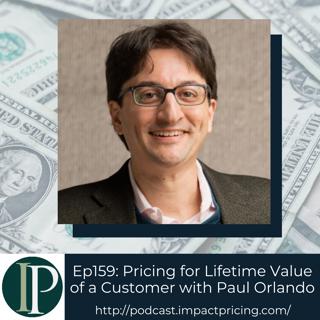
Pricing for Lifetime Value of a Customer with Paul Orlando
Paul Orlando is the Founder of Startups Unplugged and is the author of the book “Growth Units”, a book that makes unit economics straightforward. He builds incubator/accelerator programs around the world, getting companies to solve problems that they couldn’t in other ways, which allows the building of autonomy and skills that keeps employee retention high and maintains the company’s top talent. Paul is an adjunct professor and runs the incubator at USC. In this episode, Paul talks about calculating lifetime value as he shares why it is important to think about pricing in relation to the LTV. Why you have to check out today’s podcast: Understand the relationship lifetime value has with pricing and why it’s better to learn early and often than to fail fast Find out why overpricing and underpricing are present in various companies Discover why your lifetime value isn’t and will never be limited to one number “People are really afraid of raising prices. I think it was Marc Andreessen who said, 'a lot of problems go away if you can raise your prices.'” – Paul Orlando Topics Covered: 01:22 – How Paul got into the work of running incubators 03:16 – Building incubators and accelerators inside a company and changing the way people work to achieve a certain goal 06:05 – Why ‘learn early, learn often’ is a lot better than ‘fail fast’ 08:32 – Writing a book about calculating lifetime value and its components; why thinking about pricing is important 17:15 – Pricing and lifetime value; discussion about over- and underpricing 21:00 – Thinking about lifetime value in relation to subscription and non-subscription businesses 26:03 – Your lifetime value is and will never be limited to one number; why you should model the sequence of flows 29:56 – Why Paul prefers using payback time as a metric as opposed to LTV/CAC 31:23 – Paul’s pricing advice for this episode’s listeners Key Takeaways: “I actually don't want people to fail fast. I don't want them to fail slow, either. But I'd rather that they succeed fast, or second-best – succeed slow. So, I'd like to say, learn early learn often rather than fail fast. Learn early - encounter the customer upfront rather than downstream, and learn often - keep that process going like you really probably have not figured everything out just yet. You need to keep iterating. There's so much that you could test before you have committed serious resources.” – Paul Orlando “If price is some metric of value or some measure of value, you want to be able to charge something. You don't necessarily want a business that has to push prices as low as possible.” – Paul Orlando “Lifetime value is not something that you can really get a full picture of until you've been out for a while.” – Paul Orlando “These ratios or numbers that you hear about can be misleading unless you actually start digging in a bit.” – Paul Orlando “If you can start to either shorten that time, taking pre-orders, or if there's something that you can do with your own supply chain, tough today, but if there's something that you could do there, you could improve your odds of being able to use customer revenue to grow.” – Paul Orlando People / Resources Mentioned: Growth Units: Learn to Calculate Customer Acquisition Cost, Lifetime Value, and Why Businesses Behave the Way They Do: https://www.amazon.com/dp/B08GJVV8RJ/ Win Keep Grow: How to Price and Package to Accelerate Your Subscription Business: https://www.amazon.com/Win-Keep-Grow-Accelerate-Subscription/dp/1631954784 MoviePass: https://www.moviepass.com/ Uber: https://www.uber.com/ Dollar Shave Club: https://www.dollarshaveclub.com/ Amazon Web Services: https://aws.amazon.com Coke: https://us.coca-cola.com/ Connect with Paul Orlando: LinkedIn: https://www.linkedin.com/in/porlando/ Email: orlando@gmail.com Twitter: https://twitter.com/porlando Connect with Mark Stiving: LinkedIn: https://www.linkedin.com/in/stiving/ Email: mark@impactpricing.com
7 Feb 202232min

Blogcast #40: Call It Customer Impact!
This is an Impact Pricing Blog published on December 29, 2021, turned into an audio podcast so you can listen on the go. Read Full Article Here: https://impactpricing.com/blog/call-it-customer-impact/ If you have any feedback, definitely send it. You can reach us at mark@impactpricing.com. Now, go make an impact. Connect with Mark Stiving: Email: mark@impactpricing.com LinkedIn
4 Feb 20222min
